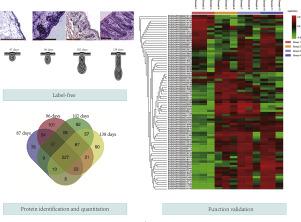当前位置:
X-MOL 学术
›
J. Proteomics
›
论文详情
Our official English website, www.x-mol.net, welcomes your
feedback! (Note: you will need to create a separate account there.)
Comparative proteomics reveals genetic mechanisms underlying secondary hair follicle development in fine wool sheep during the fetal stage.
Journal of Proteomics ( IF 2.8 ) Pub Date : 2020-05-16 , DOI: 10.1016/j.jprot.2020.103827 Tingting Guo 1 , Jilong Han 2 , Chao Yuan 1 , Jianbin Liu 1 , Chune Niu 1 , Zengkui Lu 1 , Yaojing Yue 1 , Bohui Yang 1
Journal of Proteomics ( IF 2.8 ) Pub Date : 2020-05-16 , DOI: 10.1016/j.jprot.2020.103827 Tingting Guo 1 , Jilong Han 2 , Chao Yuan 1 , Jianbin Liu 1 , Chune Niu 1 , Zengkui Lu 1 , Yaojing Yue 1 , Bohui Yang 1
Affiliation

|
The aim of this study was to investigate the genetic mechanisms underlying wool production by characterizing the skin protein profile and determining the proteomic changes that occur as a consequence of development in wool-producing sheep using a label-free proteomics approach. Samples were collected at four stages during gestation (87, 96, 102, and 138 days), and every two consecutive stages were statistically compared (87 versus 96, 96 versus 102, and 102 versus 138 days). We identified 227 specific proteins in the sheep proteome that were present in all four stages, and 123 differentially abundant proteins (DAPs). We also observed that the microstructure of the secondary follicles changed significantly during the development of the fetal skin hair follicle. The screened DAPs were strictly related to metabolic and skin development pathways, and were associated with pathways such as the glycolysis/gluconeogenesis. These analyses indicated that the wool production of fine wool sheep is regulated via a variety of pathways. These findings provide an important resource that can be used in future studies of the genetic mechanisms underlying wool traits in fine wool sheep, and the identified DAPs should be further investigated as candidate markers for predicting wool traits in sheep. SIGNIFICANCE: Wool quality (fiber diameter, length, etc.) is an important economic trait of fine wool sheep that is determined by secondary follicle differentiation and re-differentiation. Secondary follicles of fine wool sheep developed from a bud (87 days), and underwent differentiation (96 days) and rapid growth (102 days) until maturity (138 days) during gestation. Comparative analysis based on differential proteomics of these four periods could provide a better understanding of the wool growth mechanism of fine wool sheep and offer novel strategies for improving fine wool quality by breeding.
中文翻译:

比较蛋白质组学揭示了胎儿期细毛羊次级毛囊发育的遗传机制。
这项研究的目的是通过表征皮肤蛋白特征并确定因使用无标记蛋白质组学方法在产羊毛的绵羊中的发育而发生的蛋白质组学变化来研究羊毛生产的遗传机制。在妊娠期间的四个阶段(87、96、102和138天)收集样品,并每两个连续阶段进行统计学比较(87天,96天,96天,102天和102天,102天和138天)。我们在绵羊蛋白质组中鉴定了在所有四个阶段均存在的227种特定蛋白质和123种差异丰富的蛋白质(DAP)。我们还观察到,在胎儿皮肤毛囊发育过程中,次级卵泡的微观结构发生了显着变化。筛选出的DAP与代谢和皮肤发育途径密切相关,并与糖酵解/糖异生等途径相关。这些分析表明,细羊毛羊的羊毛生产通过多种途径来调节。这些发现提供了重要的资源,可用于以后对细毛羊的羊毛性状的遗传机制进行研究,并且应进一步研究已鉴定出的DAPs,作为预测羊毛性状的候选标记。意义:羊毛质量(纤维直径,长度等)是细毛羊的重要经济特征,取决于次级卵泡的分化和再分化。细羊毛羊的次级卵泡从芽(87天)开始发育,并在分化过程中经历分化(96天)和快速生长(102天)直至成熟(138天)。
更新日期:2020-05-16
中文翻译:

比较蛋白质组学揭示了胎儿期细毛羊次级毛囊发育的遗传机制。
这项研究的目的是通过表征皮肤蛋白特征并确定因使用无标记蛋白质组学方法在产羊毛的绵羊中的发育而发生的蛋白质组学变化来研究羊毛生产的遗传机制。在妊娠期间的四个阶段(87、96、102和138天)收集样品,并每两个连续阶段进行统计学比较(87天,96天,96天,102天和102天,102天和138天)。我们在绵羊蛋白质组中鉴定了在所有四个阶段均存在的227种特定蛋白质和123种差异丰富的蛋白质(DAP)。我们还观察到,在胎儿皮肤毛囊发育过程中,次级卵泡的微观结构发生了显着变化。筛选出的DAP与代谢和皮肤发育途径密切相关,并与糖酵解/糖异生等途径相关。这些分析表明,细羊毛羊的羊毛生产通过多种途径来调节。这些发现提供了重要的资源,可用于以后对细毛羊的羊毛性状的遗传机制进行研究,并且应进一步研究已鉴定出的DAPs,作为预测羊毛性状的候选标记。意义:羊毛质量(纤维直径,长度等)是细毛羊的重要经济特征,取决于次级卵泡的分化和再分化。细羊毛羊的次级卵泡从芽(87天)开始发育,并在分化过程中经历分化(96天)和快速生长(102天)直至成熟(138天)。











































 京公网安备 11010802027423号
京公网安备 11010802027423号